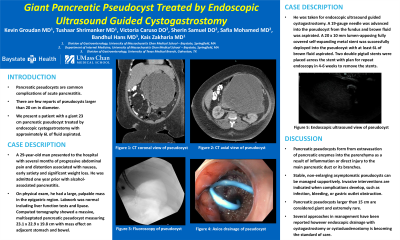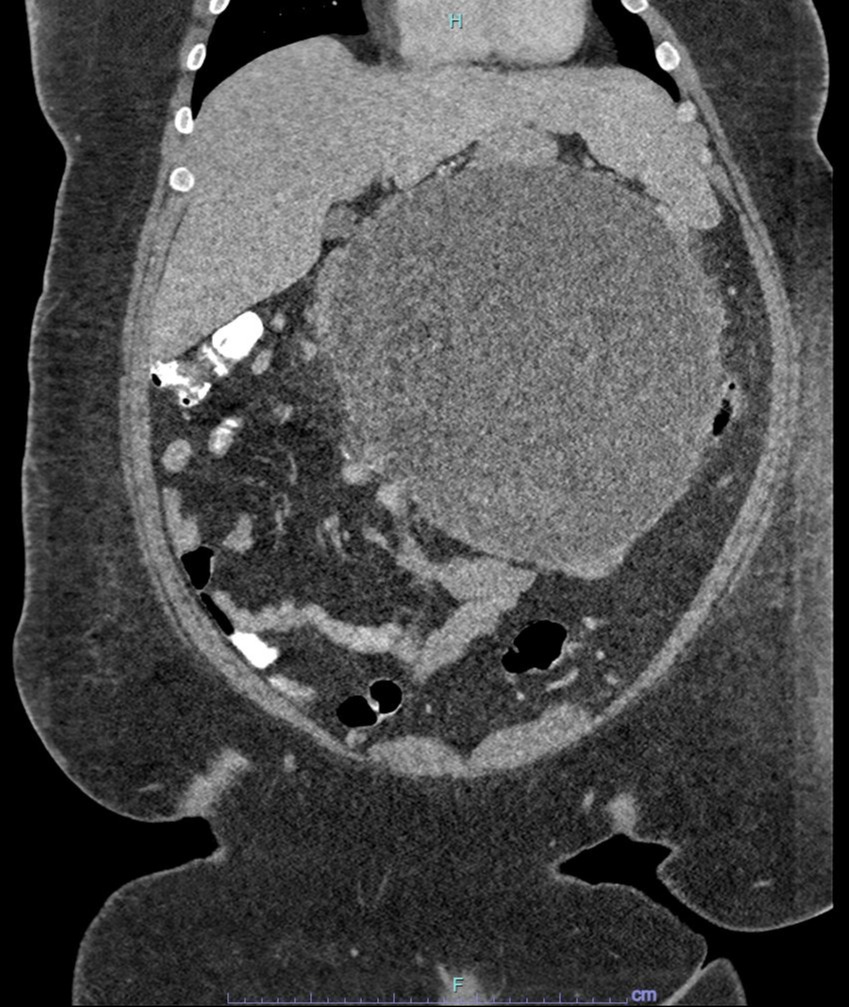Sunday Poster Session
Category: Interventional Endoscopy
P1088 - Giant Pancreatic Pseudocyst Treated by Endoscopic Ultrasound-Guided Cystogastrostomy
Sunday, October 27, 2024
3:30 PM - 7:00 PM ET
Location: Exhibit Hall E

Has Audio
- KG
Kevin Groudan, MD
University of Massachusetts Chan Medical School - Baystate
Springfield, MA
Presenting Author(s)
Kevin Groudan, MD1, Tushaar Shrimanker, MD2, Victoria Caruso, DO2, Sherin Samuel, DO1, Safia Mohamed, MD1, Bandhul Hans, MD3, Kais Zakharia, MD1
1University of Massachusetts Chan Medical School - Baystate, Springfield, MA; 2University of Massachusetts Chan Medical School - Baystate Health, Springfield, MA; 3University of Texas Medical Branch, Texas City, TX
Introduction: Pancreatic pseudocysts are common complications of acute pancreatitis. There are few reports of pseudocysts larger than 20 cm in diameter. We present a patient with a giant 23 cm pancreatic pseudocyst treated by endoscopic cystogastrostomy with approximately 6L of fluid aspirated.
Case Description/Methods: A 29-year-old man presented to the hospital with several months of progressive abdominal pain and distention associated with nausea, early satiety and significant weight loss. He was admitted one year prior with alcohol-associated pancreatitis. On physical exam, he had a large, palpable mass in the epigastric region. Labwork was normal including liver function tests and lipase. Computed tomography showed a massive, multiseptated pancreatic pseudocyst measuring 23.1 x 22.9 x 19.8 cm with mass effect on adjacent stomach and bowel.
He was taken for endoscopic ultrasound guided cystogastrostomy. A 19-gauge needle was advanced into the pseudocyst from the fundus and brown fluid was aspirated. A 20 x 10 mm lumen-apposing fully covered self-expanding metal stent was successfully deployed into the pseudocyst with at least 6L of brown fluid aspirated. Afterwards, two double pigtail stents were placed across the stent with plan for repeat endoscopy in 4 to 6 weeks to remove the stents. Patient left against medical advice after the procedure.
Discussion: Pancreatic pseudocysts form from extravasation of pancreatic enzymes into the parenchyma as a result of inflammation or direct injury to the main pancreatic duct or its branches. Stable, non-enlarging asymptomatic pseudocysts can be managed supportively. Invasive interventions are indicated when complications develop, such as infection, bleeding, or gastric outlet obstruction.
Pancreatic pseudocysts larger than 15 cm are considered giant and extremely rare. Owing to their rarity, there is limited literature on their management. Several approaches in management have been reported however endoscopic drainage with cystogastrostomy or cystoduodenostomy is becoming the standard of care.

Disclosures:
Kevin Groudan, MD1, Tushaar Shrimanker, MD2, Victoria Caruso, DO2, Sherin Samuel, DO1, Safia Mohamed, MD1, Bandhul Hans, MD3, Kais Zakharia, MD1. P1088 - Giant Pancreatic Pseudocyst Treated by Endoscopic Ultrasound-Guided Cystogastrostomy, ACG 2024 Annual Scientific Meeting Abstracts. Philadelphia, PA: American College of Gastroenterology.
1University of Massachusetts Chan Medical School - Baystate, Springfield, MA; 2University of Massachusetts Chan Medical School - Baystate Health, Springfield, MA; 3University of Texas Medical Branch, Texas City, TX
Introduction: Pancreatic pseudocysts are common complications of acute pancreatitis. There are few reports of pseudocysts larger than 20 cm in diameter. We present a patient with a giant 23 cm pancreatic pseudocyst treated by endoscopic cystogastrostomy with approximately 6L of fluid aspirated.
Case Description/Methods: A 29-year-old man presented to the hospital with several months of progressive abdominal pain and distention associated with nausea, early satiety and significant weight loss. He was admitted one year prior with alcohol-associated pancreatitis. On physical exam, he had a large, palpable mass in the epigastric region. Labwork was normal including liver function tests and lipase. Computed tomography showed a massive, multiseptated pancreatic pseudocyst measuring 23.1 x 22.9 x 19.8 cm with mass effect on adjacent stomach and bowel.
He was taken for endoscopic ultrasound guided cystogastrostomy. A 19-gauge needle was advanced into the pseudocyst from the fundus and brown fluid was aspirated. A 20 x 10 mm lumen-apposing fully covered self-expanding metal stent was successfully deployed into the pseudocyst with at least 6L of brown fluid aspirated. Afterwards, two double pigtail stents were placed across the stent with plan for repeat endoscopy in 4 to 6 weeks to remove the stents. Patient left against medical advice after the procedure.
Discussion: Pancreatic pseudocysts form from extravasation of pancreatic enzymes into the parenchyma as a result of inflammation or direct injury to the main pancreatic duct or its branches. Stable, non-enlarging asymptomatic pseudocysts can be managed supportively. Invasive interventions are indicated when complications develop, such as infection, bleeding, or gastric outlet obstruction.
Pancreatic pseudocysts larger than 15 cm are considered giant and extremely rare. Owing to their rarity, there is limited literature on their management. Several approaches in management have been reported however endoscopic drainage with cystogastrostomy or cystoduodenostomy is becoming the standard of care.

Figure: Figure 1: Massive multiseptated pseudocyst measuring 23.1 x 22.9 x 19.8 cm with mass effect on adjacent stomach and bowel
Disclosures:
Kevin Groudan indicated no relevant financial relationships.
Tushaar Shrimanker indicated no relevant financial relationships.
Victoria Caruso indicated no relevant financial relationships.
Sherin Samuel indicated no relevant financial relationships.
Safia Mohamed indicated no relevant financial relationships.
Bandhul Hans indicated no relevant financial relationships.
Kais Zakharia indicated no relevant financial relationships.
Kevin Groudan, MD1, Tushaar Shrimanker, MD2, Victoria Caruso, DO2, Sherin Samuel, DO1, Safia Mohamed, MD1, Bandhul Hans, MD3, Kais Zakharia, MD1. P1088 - Giant Pancreatic Pseudocyst Treated by Endoscopic Ultrasound-Guided Cystogastrostomy, ACG 2024 Annual Scientific Meeting Abstracts. Philadelphia, PA: American College of Gastroenterology.
